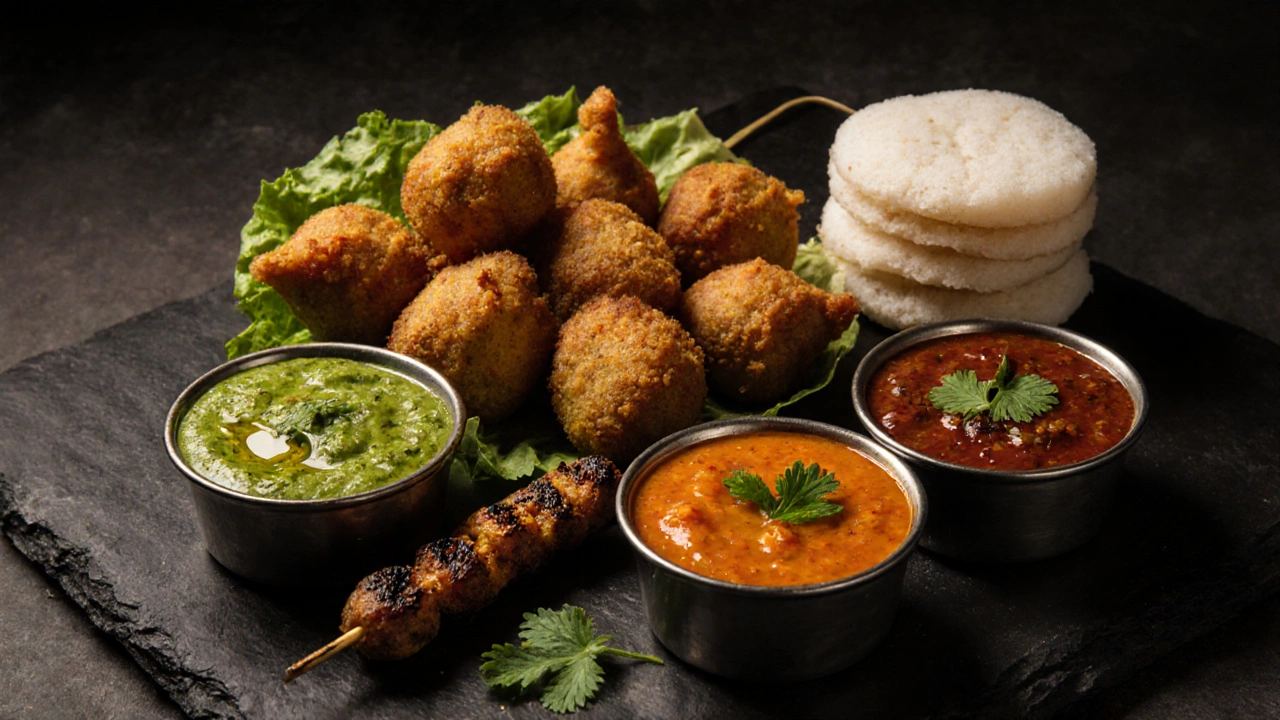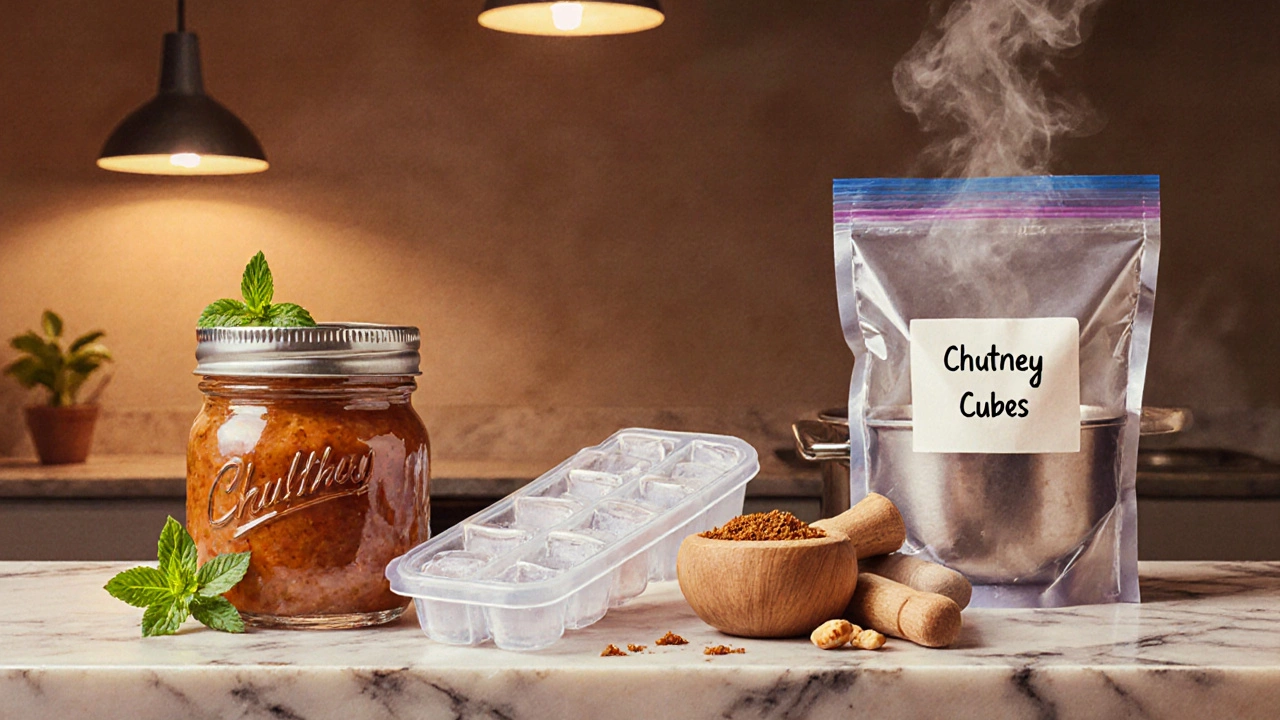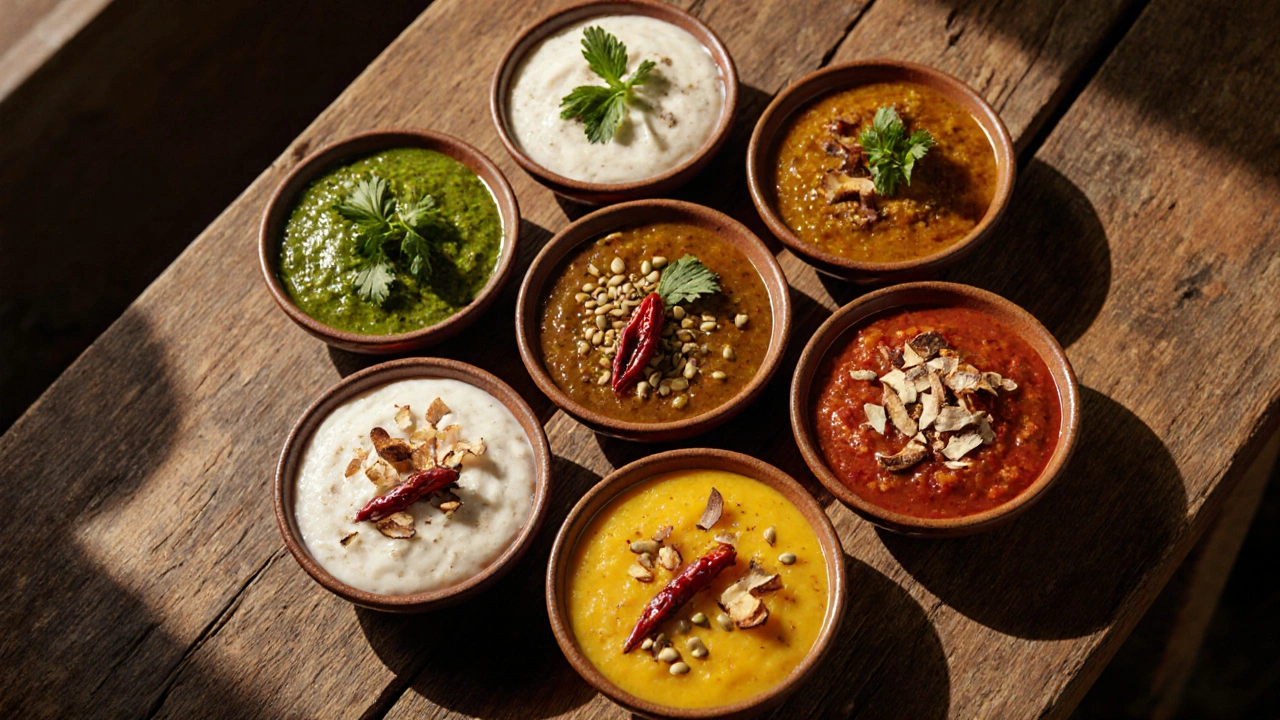Chutney Pairing Advisor
Find Your Perfect Chutney Match
Select your dish to discover the ideal chutney pairing based on the article's flavor principles
Recommended Chutney
Key Takeaways
- Match chutney flavor to the main dish - fresh herbs go with light snacks, sweet tang works best with fried foods.
- Serve chutney at room temperature for the best bite.
- Store homemade chutney in airtight jars; refrigerate for up to a week, freeze for longer keep.
- Use small, shallow bowls so guests can dip without over‑scooping.
- Experiment with quick hacks: blend leftovers, add a splash of lemon, or toss in toasted nuts.
What is Indian Chutney?
When talking about dip culture, Indian chutney is a flavor‑packed condiment made from herbs, spices, fruit or vegetables, commonly served with breads, rice dishes, and snacks. It can be smooth or chunky, spicy or sweet, and the taste profile changes dramatically based on the main ingredient. Because it’s so versatile, chutney is the secret weapon that turns a simple bite into a flavor explosion.
Common Types of Chutney and Their Flavors
Below are the most popular varieties you’ll find on Indian tables. Each brings its own personality, so pick the one that matches the dish you’re serving.
Mint Chutney
Fresh mint leaves blended with green chilies, cilantro, lemon juice, and a pinch of sugar create a cool‑spicy dip. It’s bright, herbaceous, and perfect for grilled kebabs or spring rolls.
Coconut Chutney
Ground coconut mixed with roasted chana dal, mustard seeds, curry leaves, and a splash of water. The result is a creamy, mildly sweet sauce that pairs wonderfully with South Indian staples like dosa and idli.
Tamarind Chutney
Made from tamarind pulp, jaggery, roasted cumin, and chili powder, this chutney is sweet, sour, and a little spicy. It shines as a dipping sauce for chaat, samosas, and fried pakoras.
Tomato Chutney
Cooked tomatoes blended with garlic, red chilies, and a hint of mustard seeds. Its tangy depth works well with roasted parathas or grilled paneer.
Peanut Chutney
Roasted peanuts ground with chilies, ginger, and tamarind. The nutty richness balances spicy street foods like bhajias.

How to Pair Chutney with Everyday Indian Dishes
Pairings follow a simple rule: balance the dominant flavor of the main food with a contrasting or complementary chutney.
- Light, steamed items (idli, dhokla, steamed momos) - go with mint or coconut chutney. The fresh herbs cut through the gentle texture.
- Fried or deep‑fried snacks (samosa, pakora, bhujia) - reach for tamarind or peanut chutney. Sweet‑sour or nutty notes offset the oil.
- Grilled meats and kebabs - mint chutney adds a cooling effect that tempers charred heat.
- Rich breads (paratha, naan, roti) - tomato or onion chutney adds a juicy bite, preventing the bread from feeling heavy.
- Rice‑based dishes (biryani, pulao, curd rice) - a spoonful of coconut or mint chutney brightens the palate.
When you serve a mixed platter, offer two contrasting chutneys side by side. The visual contrast also looks inviting on the table.
Serving Tips: When and How to Offer Chutney
Here’s a quick checklist to make sure your chutney looks and tastes its best.
- Bring chutney to room temperature. Cold dip can mute flavors, especially for herb‑based varieties.
- Use small, shallow bowls or ramekins. Guests can dip without scooping too much, keeping the rest fresh.
- Place a spoon or small ladle next to each bowl for hygienic serving.
- If you’re serving multiple chutneys, arrange them from mildest to spiciest. This guides diners to explore gradually.
- Garnish with a sprinkle of fresh herbs, toasted seeds, or a drizzle of oil for visual pop.
Storing and Reviving Chutney
Homemade chutney lasts longer when you treat it right.
- Refrigeration: Transfer to a clean glass jar, seal tightly, and store in the fridge. Most chutneys stay fresh for 5‑7 days.
- Freezing: Portion into ice‑cube trays, freeze, then move to a zip‑lock bag. Thaw in the fridge and stir before serving.
- Reviving: If the texture thickens, whisk in a tablespoon of water, lemon juice, or coconut milk until smooth.
- Avoid metal lids on acidic chutneys (like tamarind) to prevent off‑flavors.

DIY Quick Chutney Hacks
Even if you’re short on time, you can whip up a tasty dip using pantry staples.
- Leftover herbs: Blend wilted cilantro with a squeeze of lime, a pinch of salt, and a handful of peanuts for an instant pesto‑style chutney.
- Spice boost: Toss a spoonful of garam masala into plain coconut chutney to create a warmth in every bite.
- Sweet‑sour shortcut: Mix equal parts store‑bought mango pickle juice with yogurt for a tangy dip that mimics tamarind chutney.
- Texture tweak: Add crushed roasted makhana (fox nuts) to any chutney for a crunchy surprise.
Chutney Comparison Table
| Chutney | Main Ingredient | Flavor Profile | Best Pairings | Typical Region |
|---|---|---|---|---|
| Mint | Mint leaves + cilantro | Cool, herbaceous, mild heat | Kebabs, spring rolls, chaats | North India |
| Coconut | Fresh coconut + chana dal | Creamy, slightly sweet | Dosa, idli, rice | South India |
| Tamarind | Tamarind pulp + jaggery | Sweet‑sour, tangy, medium heat | Chaat, samosa, pakora | West India |
| Tomato | Tomatoes + mustard seeds | Tangy, savory, mild heat | Paratha, paneer, grilled fish | All regions |
| Peanut | Roasted peanuts + chilies | Nutty, spicy, slightly sour | Bhajias, vada, street snacks | Western & Central India |
Frequently Asked Questions
Can I use Indian chutney with non‑Indian foods?
Absolutely. Mint chutney works as a fresh spread on grilled chicken sandwiches, while coconut chutney can replace mayo in a veggie wrap. The key is to match intensity - use milder chutneys with delicate dishes and bold ones with hearty plates.
How long does homemade chutney stay good in the fridge?
Most herb‑based chutneys (mint, coriander) keep for 5‑7 days. Coconut and peanut versions can stretch to 10 days because of their fat content. Always check for discoloration or off smells before using.
Is it okay to reheat chutney?
Yes, but do it gently. Heat a spoonful in a pan over low flame for 30 seconds, stirring constantly. Over‑cooking can dull fresh herbs and turn coconut chutney grainy.
What’s the best way to freeze chutney?
Portion into ice‑cube trays, freeze until solid, then transfer to a zip‑lock bag. Thaw in the refrigerator and stir in a splash of water or lime juice to bring back the original texture.
Can I make chutney without a blender?
Sure. Use a mortar and pestle for traditional texture - it gives a rustic feel and releases more aroma. For coarse sauces, a grater and a whisk work fine.
